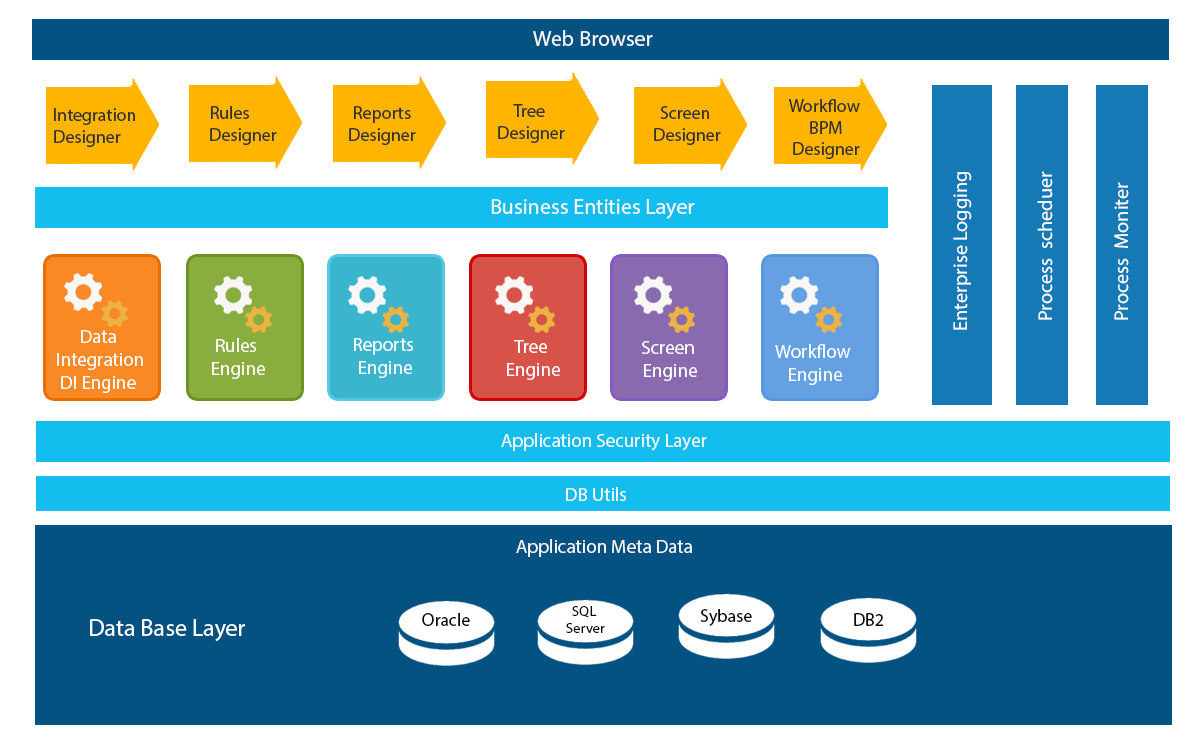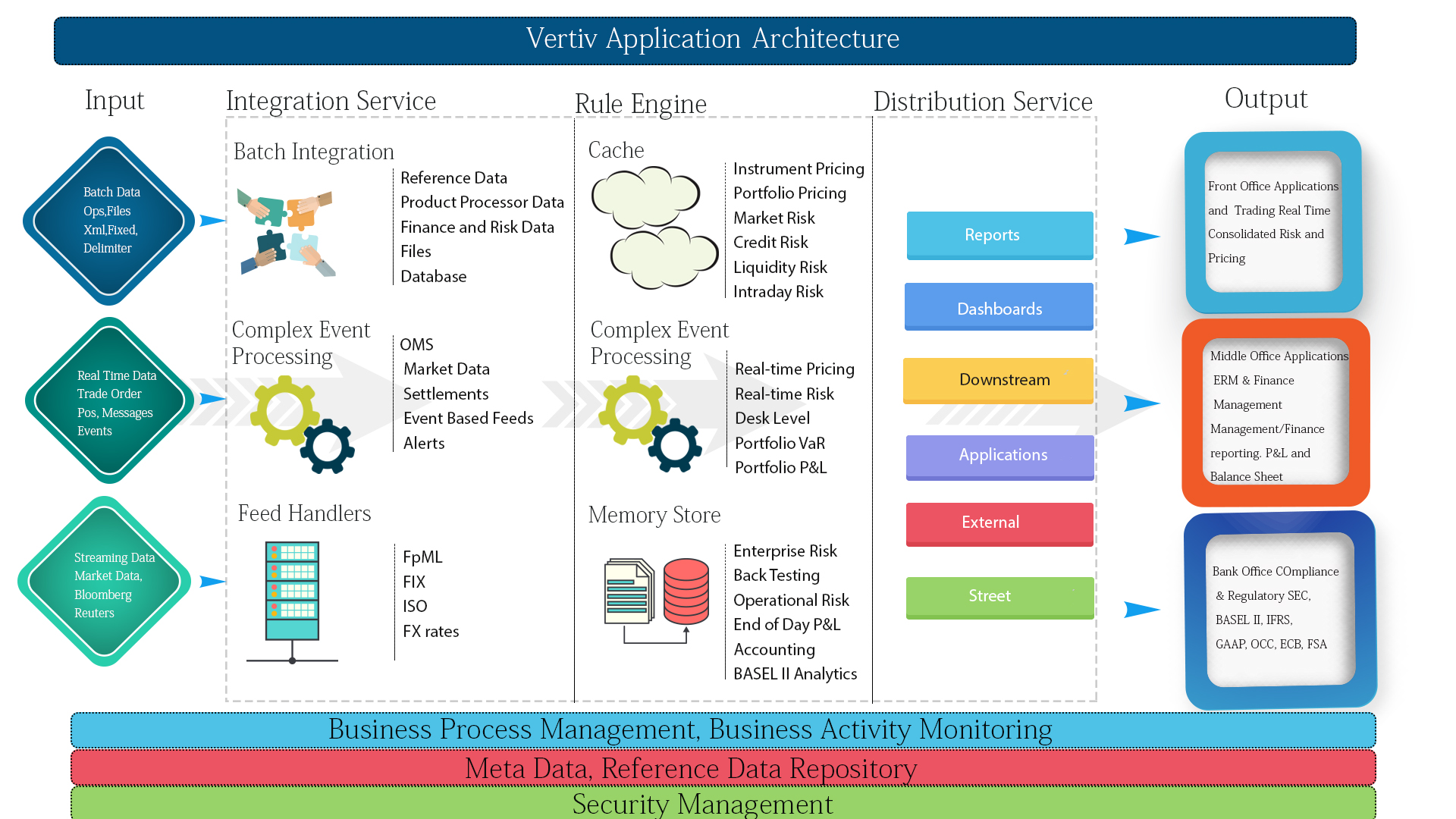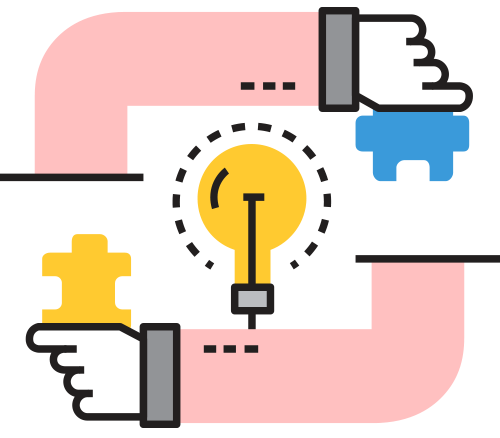vertiv Studio
vertiv Studio provides a comprehensive development toolset that supports the development and runtime of vertiv applications, such as vertiv RQuest, FinQuest and InvQuest. By leveraging metadata and other efficiencies within the toolset, application developers build and customize the vertiv applications quickly and easily.
vertiv Tools Value Proposition
vertiv Tools continues to focus on and deliver:
Technology Optimization.
Platform Stability and Product Growth.
Maintainability, Quality, and Performance.
Greater User Productivity.
Application



vertiv Advantages:
Low total cost of ownership
The key value of the vertiv studio is in the adoption of new technology releases and supportability improvements that reduce ongoing operating costs. vertiv Studio delivers unparalleled customer choice that ensures support of the latest technical innovation with the industry's lowest cost of ownership.
Better Insight for Better Business
vertiv Studio is designed with the aim to protect and extend your current investments in your Enterprise implementation. We are also dedicated to providing an evolutionary path to integrate with your current application infrastructure

Data Designer
General objective of Data Designer is to enable the creation and management of metadata. Data Designer in data creation and management of metadata, we have provided an introduction to how Data Designer provides a fully functional interface for custom data models. With such an interface, a user can enter metadata or data as specified and validated by the data model. However, data persistence and change management in a collaborative manner between users is also a key requirement.
Current form of Data Designer is an Eclipse tool based on the Eclipse Modeling Framework (EMF) EMF and Client Platform (ECP). As such, an Ecore model has been implemented to allow the auto code generation and data Designer platform. The written Ecore model is a variation of the European model data point was also used to model the framework CRD IV / CRR, also known as FinRep and CoRep.
In addition DataDesigner should Include:
We have the opportunity for a Data Designer to work in digital technology for our function Personal & Business Banking (PBB). Using your expertise, you design, create and implement a physical data model and the review and provide data for designers. This role is ideal if you want to work in the digital strategy where you will help define, refine and promote our digital offering to better serve our customers. You have significant experience in the management and specification of the objects as well as background in conducting the business analysis of the data model, design and development in a large-scale transactional organization.
Understand and model of the industry increasing assets such as DRE models and metadata dictionaries as taxonomies and business conditions.
An ability to analyze the source and target information, map their business glossaries and object models based on business needs.
working with business analysts, architects Affairs Service Designers, Designers and Technical Architects to specify a requirement in a solution
Screen Designer
vertiv Studio comes with a powerful Screen Designer to develop any custom screens as need be. This is part of vertiv Development Tool Set.
Features
Developers can easily develop screens without writing any code.
All Screen Components, Look and Feel, database operations can be easily configured.
An administrator can allow different kinds of changes to different groups of developers enabling complete control of what can, or can't change.
Meta Data driven presentation Tool to create any application screen with no coding by the developers.
Business Users can develop the screens, tables, components and menus to configure new application functionality.
All this through a simple to use and manage browser driven interface.
Data Integration Engine
Data Integration Engine provides users a powerful way to load heterogeneous data from different sources. Part of vertiv Integration Tool Set.
Features
Batch Data: Data from Product processors, Finance data and other forms of data can be loaded into the application in different formats like Text, CSV, fixed length, delimited, XML files and imported directly from any third party database depending on the needs of organization
Streaming Data: Market data, FIX, FpML, ISO and other types of data can be acquired using Data Integrator.
Data integration Engine uses ELT (Extract Load and Transform) approach.
Data integration Engine works inbound as well as outbound tool to distribute the data in given format.
Real time/event data: Using Complex Event Processing engines, event data can be brought into the application.
Creates data structures, default screens, source profiles and data target data models.
All this through a simple to use and manage through browser driven interface.
Rules Engine
Rule engine provide users very flexible and highly efficient way of defining and executing Business Rules. Rule Engine is part of vertiv Development Tool set to create Processes to carry out Business Logic.
Rule designer is used to define and manage Business rules in an effective dated way so that the rules can be in the system in a way such that last moment migrations and issues are avoided.
Support for different types of rules such as Data Manipulation, Enrichment, Standardization, Transformation, Aggregation, Consolidation, Reconciliation, Allocation and Accounting are supported based on the product licensing.
Rules can be easily organized into Rule Sets and into Function/Organizational needs.
Rules can be executed real time, or batch processing mode.
Rules can be grouped using Rule Sets and executed on demand. Rules are fully audited, effective dated, version controlled and owned by business people.
All this through a simple to use and manage browser driven interface.
Rule Engine user interface is easy-to-use for different types users such business users, and developers.
Rule Engine Generates optimized code based native database or native system parameters.
Modeling Engine
Modeling Engine provide users very flexible and highly efficient way of defining and executing Business Rules. Rule Engine is part of vertiv Development Tool set to create Processes to carry out Business Logic.
Features
Rule designer is used to define and manage Business rules in an effective dated way so that the rules can be in the system in a way such that last moment migrations and issues are avoided.
Support for different types of rules such as Data Manipulation, Enrichment, Standardization, Transformation, Aggregation, Consolidation, Reconciliation, Allocation and Accounting are supported based on the product licensing.
Rules can be easily organized into Rule Sets and into Function/Organizational needs.
Rules can be executed real time, or batch processing mode.
Rules can be grouped using Rule Sets and executed on demand. Rules are fully audited, effective dated, version controlled and owned by business people.
All this through a simple to use and manage browser driven interface.
Rule Engine user interface is easy-to-use for different types users such business users, and developers.
Rule Engine Generates optimized code based native database or native system parameters.
Reconciliation Engine
Reconciliation Engine offers the capabilities of automating the reconciliation process between multiple data sets (e.g. Finance-risk reconciliation, Core Banking Systems-Financial Systems, Core Banking Systems-Point of Sales systems). It is designed using a common rules framework and a web based application interface. Operational users can setup reconciliation rules starting with the loading of data through the Integration engine, enriching and transforming the data using the Rule Engine and performing reconciliation between multiple sources.
Features
Easy-To-Use: Business Users can define sources through Integration Engine, Load, Define reconciliation Rules.
Exception Handling: Reconciliation un-matched thresholds can be setup and exceptions are configurable.
Error Handling: Users can re-run or re-process when errors occurred.
Notifications and Alerts: Notifications and Alerts are configurable when exceptions are occurred, or errors occurred.
Maker-Checker Process: Built in Maker-Checker Process using workflow engine and security manager integration
Manual Processes: Users can manually do matching process using the data screens in reporting explorer.
Excel and Forms Integration: Excel, files and other sources are easily configurable and be loaded in ELT mode for reconciliation and also results are distributed using excel sheets, forms and files.
Dashboards, Graphs and Portals: Operational Dash boards, Graphs and Charts are configurable and integrated with Recon Engine
BPM/Workflow Engine
vertiv workflow engine offers robust functionality and visual process modeling. Workflow Engine allows to easily converting any business process into a browser-based, web-enabled application without programming or development. With its easy-to-use graphical interface, user can define the functionality of a process simply by typing instructions and Connecting the workflow. Workflow Engine is part of vertiv Integration Tool Set.
Features
Automated Workflow Capabilities: Workflow automation allows automatic routing of items based on pre-determined business rules.
Dynamic Queues: Dynamic queues consist of all the tasks each employee is subscribed or assigned to, in order of their particular priorities.
Parallel Processes: Step by step sequential processes are enabled, which is a typical feature in workflow automation. However, Workflow Engine takes this a step further with powerful parallel processing, which allows for multiple tasks to occur simultaneously within your workflow.
No Coding or Programming: Workflow Engine allows for a seamless correlation of data when creating your business workflow processes and integrating them with other key line of business systems through its easy to use GUI based workflow creation screen. Designing and managing the workflow is configurable without complex scripting, coding or programming.
Reporting & Monitoring: Reporting and performance metrics are a powerful feature of Workflow Engine.
Increased Accountability & Improved Audit Trails: Workflow creates a clear picture of your organizational processes that are driving the business. A comprehensive audit trail of all actions will be available, increasing your users accountability
Reporting Engine
Report engine is an easy to use End user driven tool to create and consume Reports. Report Engine is part of vertiv Analytical Tool Set.
Features
The Report Designer is a simple to use tool where the data is exposed in a Business friendly fashion by hiding all the technical details from end users.
Provides different types of reports like Tabular, Chart, Forms Based Reports.
Business users can design reports from universes created s business areas.
All this through a simple to use and manage browser driven interface.
Hierarchy Manager
Defining Hierarchies in the application is a very easy task in vertiv Studio. Hierarchy Manager is heart of the vertiv Studio components, been used in most or all of the tool sets though it is part of vertiv Analytical Tool Set.
Features
The utility provides users the ability to define variety of hierarchies.
There is support for Homogenous and Heterogeneous Hierarchies.
On-demand/Load-all Hierarchies are just a click away.
Process Scheduler & Job Manager
All the jobs in the application can be scheduled using inbuilt Job Scheduler. This is part of Administrative & Operational Tool Set
Jobs or sets of Jobs can be configured and executed as needed with desired dependencies defined.
Job execution status can be easily monitored using provided Monitoring tools.
Future jobs can be put on hold, killed, postponed as needed.
External jobs can be kicked off using the scheduler.
Security & Entitlement Manger
Using Security & Entitlement manager users can configure Security requirements. Part of Administrative & Operational Tool Set
A single simple to user interface is available to configure application security and entitlements. Screens, Reports, DI, Trees and any other application resources can be secured as need be.
Data level security can also be configured.
All this through a simple to use and manage browser driven interface.
Change Manager
Using Change Manager System Life Cycle Management, Change Management Team can use to identify the new fixes, patches, impact analysis, and upgrade path. Part of Life Cycle Management Tool Set.
Automates the process of installing software patches, updates, and upgrades, reducing the time required for application updates. vertiv Change Manager uses the vertiv product updates to retrieve only those patches that are needed for a specific vertiv environment
Helps you determine the impact of specific changes you plan to make during an application upgrade. It's an interactive program where you can see the relationships of vertiv definitions in a hierarchical view.
GUI Driven Migration assistant to move code between vertiv Environments through Data Mover approach as Meta Data.